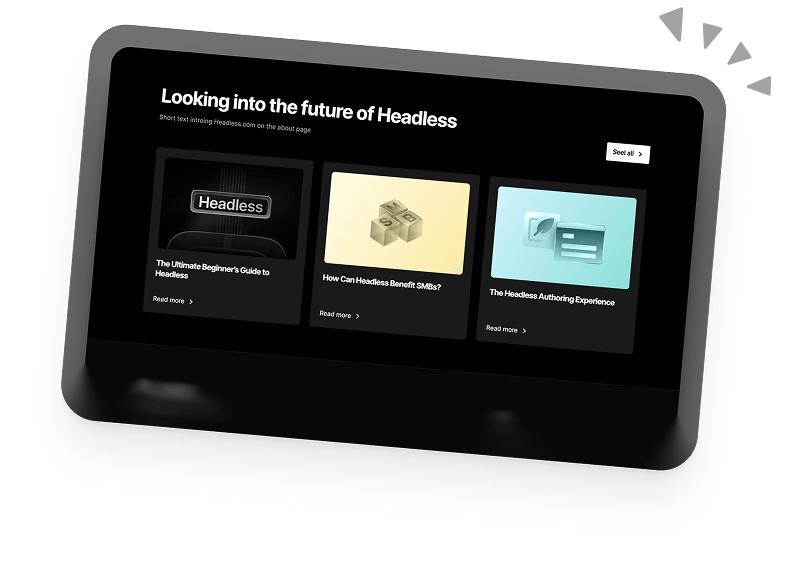4 Reasons You Shouldn't Use Headless
With so much excitement around the Headless CMS, you might be asking yourself: “should I go Headless?”
Choosing a suitable CMS can make a world of difference to your business, for better or worse. And while we’re big fans of Headless at Drewl, we know from experience that it’s not the right fit for every project.
American economist Michael Porter once said: “The essence of strategy is choosing what not to do”. So, with these wise words in mind, we’re going to look at 4 reasons you should not use Headless.
But first, let’s take a quick overview of Headless and how it has built so much excitement in the world of web design.
Why is Headless so popular?
As user experiences become a top priority for digital expansion, people are looking for ways to make their sites faster, prettier, and more personalised. Not only that, but they’re working to enhance every aspect of their user’s journey and to optimise every possible digital touchpoint.
Then along comes…
The Headless CMS
…and everyone loses their minds.
Its front-end agnostic architecture promises total developer freedom, enhanced performance and security, and the ability to control all the channels you need: all from one place.
In the past few years Headless has seen widespread adoption, with 64% of enterprise organisations using Headless technology in 2021 (a 25% increase from 2019).
Why Headless might not be right for you
1.You don’t need that many channels
The idea behind a Headless website is to function like a swiss army knife, allowing you to manage as many “heads” as you want. You can house all your content in one place and distribute it to sites, apps, smart devices, emails…pretty much anywhere.
While this is an ideal solution for enterprises with an omnichannel presence, if you’re only managing a single website, an app, and a social media feed, Headless might be overkill. (Sort of like using NASA’s mission control centre to change the channels on your TV.)
Given the time and resources required to set up a Headless CMS, you’ll want to make sure you’re in a position to get the most out of the features on offer. Ultimately, if you’re not swamped in content channels, it’s probably simpler to pass on the Headless.
2. You don’t have a team of developers
People love Headless CMSs for the flexibility and creativity they give developers. But being this flexible means that Headless is essentially a DIY option, so you won’t have any built-in themes or easy-to-install plugins to build on.
Since it doesn’t come with many out-of-the-box features, a Headless CMS relies heavily on developer resources to get it up and running. The entire presentation layer will need to be built from scratch and then configured with APIs. A lot of functionality, such as plugins, will also need to be custom-built. As such, you’ll need to be prepared for a substantial initial investment while deploying Headless.
You also need to consider the added costs of maintaining your CMS. While one of the benefits of Headless is the ability to scale front and back-ends separately, this also means spending more time and money for developers to manage each end individually. Furthermore, since any tweaks to the front-end must be made manually, having in-house developers is a must if you’re going Headless.
3. You’re attached to your authoring experience
The switch to Headless is often jarring for content creators and marketers as it changes the way you post and manage content.
Being detached from the front-end means you can’t preview content before you post it. This lack of WYSIWYG (what you see is what you get) editing can create a disconnect in your authoring experience.
As we mentioned above, any formatting errors that come up after posting will often have to be dealt with by developers. This can cause delays in content publication and be annoying for both authors and developers. And if your Headless setup is poorly implemented, this can quickly become a regular (and tedious) issue.
4. It’s not the right fit (just yet)
Headless is far from being a “one size fits all” solution. While it’s become a more popular solution for digital experiences in recent years, it can become a hindrance if it’s not suited to your business needs. Headless CMSs are best suited for SMEs or large enterprises who need to manage multi-channel touchpoints, enhance speed, provide flexible design, and more.
Headless for SMBs
For smaller companies, it can be difficult to successfully manage a Headless website. However, at Drewl, we’re working to make Headless more accessible to companies of all sizes. We’ve developed internal frameworks that create more streamlined development experiences and drastically reduce the timespan for deploying smaller Headless projects.
With this approach, we’re providing more businesses with the perks of a Headless CMS while eliminating some of the drawbacks.
The big question
So, do you think Headless is for you?
If you feel that Headless might not be right for you after all, then don’t worry! You don’t have to miss out on all the juicy perks of a Headless CMS. There are plenty of design and development services that can boost your brand’s digital experience and even alternative CMS options that might be better suited to your needs.
On the other hand, if you feel like you might want a Headless CMS, then check out our Headless services or get in touch with us if you have any questions.
Book a 30-min Introduction Call
Let's jump on a quick intro call We'll break down your project, and pinpoint exactly how we can help.



Our clients  Holaa! love working with us see their stories below!
Holaa! love working with us see their stories below!






